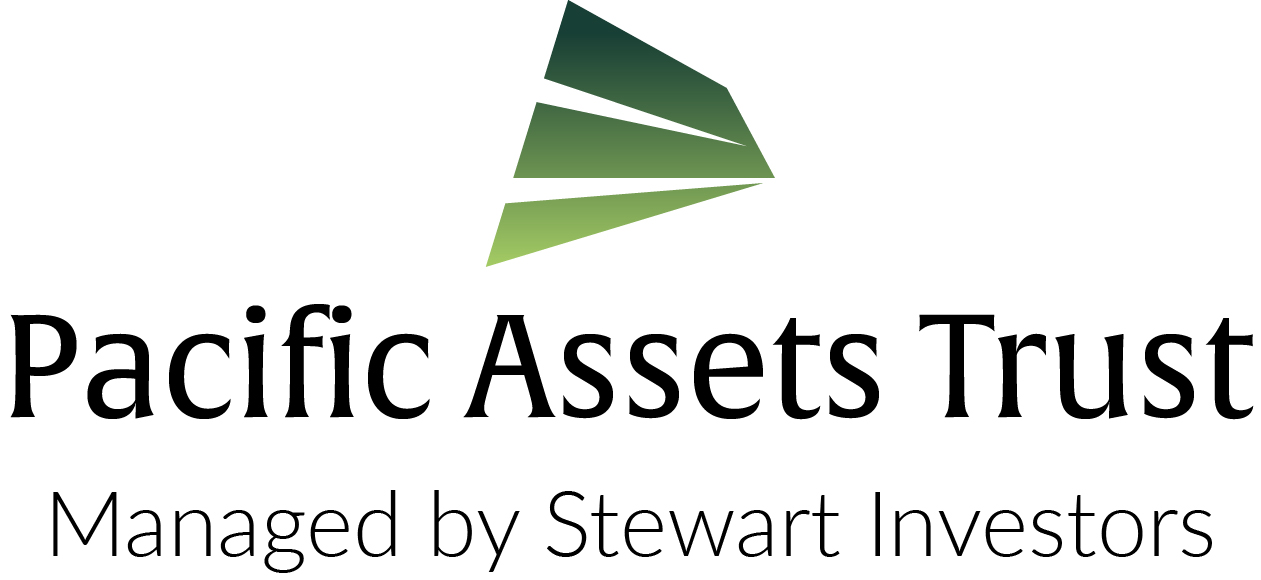
Price & performance
Latest and historic performance ot the Trust.
Risk factors
This web page is a financial promotion for Pacific Assets Trust plc (the “Trust”) only for those people resident in the UK and Ireland for tax and investment purposes.
Investing involves certain risks including:
- The value of investments and any income from them may go down as well as up and are not guaranteed. Investors may get back significantly less than the original amount invested.
- Emerging market risk: emerging markets tend to be more sensitive to economic and political conditions than developed markets. Other factors include greater liquidity risk, restrictions on investment or transfer of assets, failed/delayed settlement and difficulties valuing securities.
- Specific region risk: investing in a specific region may be riskier than investing in a number of different countries or regions. Investing in a larger number of countries or regions helps spread risk.
- Currency risk: the Trust invests in assets which are denominated in other currencies; changes in exchange rates will affect the value of the Trust and could create losses. Currency control decisions made by governments could affect the value of the Trust’s investments.
- The Trust’s share price may not fully reflect its net asset value.
Where featured, specific securities or companies are intended as an illustration of investment strategy only, and should not be construed as investment advice or a recommendation to buy or sell any security.
For an overview of the terms of investment, risks, returns, costs and charges please refer to the Key Information Document.
If you are in any doubt as to the suitability of the Trust for your investment needs, please seek investment advice.
Price charting
| Period | Since inception | 10 yrs | 5 yrs | 3 yrs | 1 yr | 6 mths | 3 mths |
|---|---|---|---|---|---|---|---|
| NAV | 270.7 | 102.2 | 51.6 | 8.9 | -3.3 | -8.9 | -0.6 |
| Share price | 262.8 | 79.4 | 45.6 | 8.7 | -5.3 | -9.1 | 0.3 |
| CPI + 6%*** | 274.3 | 151.1 | 71.6 | 37.7 | 9.9 | 5.4 | 3.6 |
| Peer group return | 250.3 | 127.7 | 39.0 | 5.9 | 2.1 | -0.8 | -0.5 |
| MSCI AC Asia ex Japan Net Index** | 153.6 | 73.9 | 27.8 | 9.7 | 8.4 | 1.9 | -1.0 |
| Period | 12 months to 31/05/25 | 12 months to 31/05/24 | 12 months to 31/05/23 | 12 months to 31/05/22 | 12 months to 31/05/21 |
|---|---|---|---|---|---|
| NAV | -3.3 | 3.0 | 9.4 | 2.4 | 35.9 |
| Share price | -5.3 | 0.3 | 14.4 | -3.6 | 38.9 |
| CPI + 6%*** | 9.9 | 8.6 | 15.3 | 15.7 | 7.8 |
| Peer group return | 2.1 | 8.6 | -6.1 | -12.2 | 49.1 |
| MSCI AC Asia ex Japan Net Index** | 8.4 | 8.3 | -6.5 | -11.6 | 31.8 |
Past performance is not a reliable indicator of future results.
Although the Company will use the MSCI AC Asia ex Japan Index and CPI +6% as comparator indices, these indices will not be used for portfolio construction or risk management purposes.
These figures refer to the past. Past performance is not a reliable indicator of future results. For investors based in countries with currencies other than GBP, the return may increase or decrease as a result of currency fluctuations. The NAV performance data is on a net basis after deducting all fees (e.g. investment management fee) and costs (e.g. transaction and custody costs) incurred by the Trust. The NAV includes dividends reinvested on a net of tax basis. CPI data is quoted on a one month lag. The peer group is a subset of the Association of Investment Companies peer group, considered by the board as those whose investment policies are substantially similar to those of the Trust. Peer group performance is determined on a simple average share price basis by measuring percentage growth over the period using bid prices, on the basis that net income is reinvested in Sterling. The comparator shown is the MSCI AC Asia ex Japan Index, on an income reinvested net of tax basis. Sources: i) Lipper for Trust and peer group share prices returns; ii) Trust Administrator and Bloomberg for NAV performance data; iii) CPI data is sourced from Factset.
Performance since Stewart Investors was appointed as portfolio manager with effect from the 1st July 2010.
** The MSCI AC Asia ex Japan Index is shown here as a comparator to provide additional context for investors seeking exposure to the region.
*** The Performance Objective is considered to be appropriate given the portfolio manager’s index agnostic investment philosophy and will not change its style or strategy, or the make-up of the portfolio.
| Ex Div | Record Date | Pay Date | Typeǂ | Pence/Share |
|---|---|---|---|---|
| 12 June 2025 | 13 June 2025 | 11 July 2025 | Final | 4.9 |
| 13 June 2024 | 14 June 2024 | 12 July 2024 | Final | 4.0 |
| 8 June 2023 | 9 June 2023 | 6 July 2023 | Final | 2.3 |
| 9 June 2022 | 10 June 2022 | 1 July 2022 | Final | 1.9 |
| 13 May 2022 | 14 May 2022 | 5 July 2022 | Final | 2.4 |
| 28 May 2020 | 29 May 2020 | 2 July 2020 | Interimǂǂ | 3.0 |
| 30 May 2019 | 31 May 2019 | 4 July 2019 | Final | 3.0 |
| 31 May 2018 | 1 June 2018 | 4 July 2018 | Final | 2.6 |
| 1 June 2017 | 2 June 2017 | 4 July 2017 | Final | 2.6 |
| 2 June 2016 | 3 June 2016 | 4 July 2016 | Final | 2.2 |
| 28 May 2015 | 29 May 2015 | 29 June 2015 | Final | 2.6 |
| 28 May 2014 | 30 May 2014 | 27 June 2014 | Final | 2.6 |
| 29 May 2013 | 31 May 2013 | 28 June 2013 | Final | 2.6 |
| 30 May 2012 | 1 June 2012 | 29 June 2012 | Final | 2.6 |
| 1 June 2011 | 3 June 2011 | 30 June 2011 | Final | 1.29 |
| 2 June 2010 | 4 June 2010 | 30 June 2010 | Final | 1.29 |
| 20 May 2009 | 22 May 2009 | 19 June 2009 | Final | 1.29 |
ǂ A Final Dividend is a dividend declared by the Board of Directors after the company has issued its annual financial statements.
ǂǂ In light of the response to the coronavirus pandemic in 2020 the board decided to declare an interim dividend rather than a final dividend. Declaring an interim dividend means that shareholders would be paid a dividend irrespective of whether the AGM was able to proceed as planned. Please see annual report for further details.
Glossary
Discrete performance: This is the performance over a specific time-period. In this case, it’s over one year up until the date shown, annually. This performance is shown net of fees, which means after any fees have been deducted.
Cumulative performance: This is the performance of the Trust over the time periods shown in the table. This performance is shown net of fees, which means after any fees have been deducted.
NAV%: Net asset value is the total value of all of the Trust’s investments and cash, less any debts or loans.
CPI+6%: The trust’s performance objective against which the Portfolio Manager’s performance is measured is to provide shareholders with greater than the UK Consumer Price Index (CPI) plus 6%. CPI is a measurement of price changes for consumers. The additional 6% is what the Board considers to be a reasonable increase from investing in the faster-growing Asian economies over the long term.
Peer Group ReturnThe Board also monitors the Company’s performance against its peer group of five other investment trusts with similar investment mandates and one exchange traded fund (“ETF”). It is a subset of the Association of Investment Companies peer group, considered by the board as those whose investment policies are substantially similar to those of the Trust
MSCI AC Asia ex Japan Index: An index is a collection of investments designed to replicate the performance of a region or a specific market. Investors can use this one as a way of comparing the Trust’s performance because it is the closest geographically to the countries in which the Trust invests.
Dividends: This is a payment made to the Trust’s shareholders.
Net-Asset-Value (NAV): This is the value of all the Trust’s investments and cash minus its debts.
Net-Asset-Value (NAV) per share: This is the value of the Trust expressed per share. It is calculated by dividing the NAV by its shares outstanding.
Cum Income NAV Per Share (p): This reflects the NAV per share including the income the Trust has received in the current financial year.
Cum Income Discount / Premium (%): This is the percentage difference between the share price and the Cum Income Nav Per Share. A positive difference means that the share price is trading at a premium and negative percentage difference means that the share price is trading at a discount over its NAV including income.
Ex-Income NAV Per Share (p): This reflects the NAV Per Share excluding the income the Trust has received in the current financial year.
Ex-Income Discount / Premium (%): This is the percentage difference between the share price and the Ex-Income NAV Per Share. A positive difference means that the share price is trading at a premium (over its NAV excluding income) and a negative percentage difference means that the share price is trading at a discount to its NAV excluding income.
Ex Div or Ex-dividend: This means that the share price of the Trust is trading without the value of the next dividend payment.


